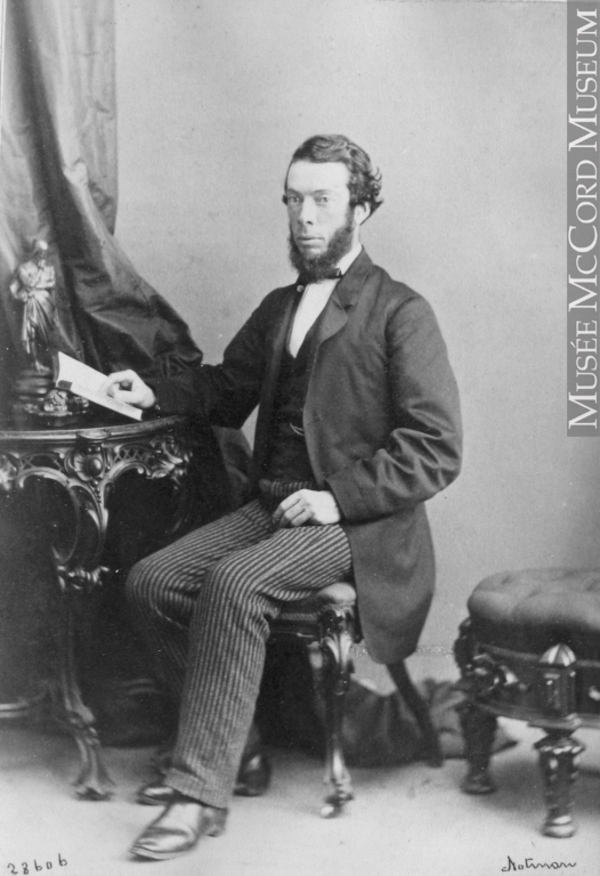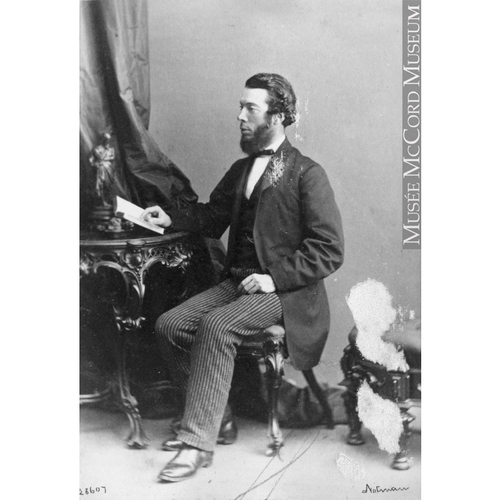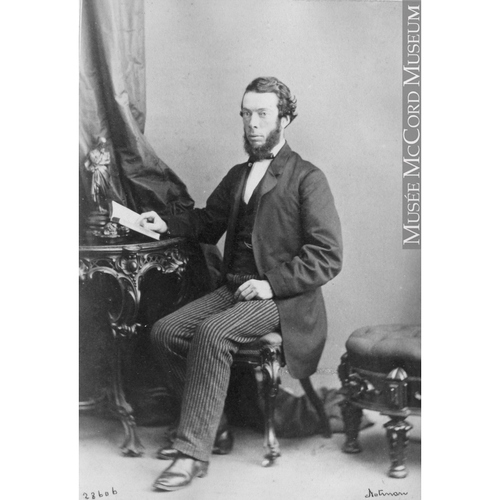
Source: Link
MUNN, ROBERT STEWART, merchant and politician; b. 23 Aug. 1829 in Bute, Scotland, son of Dugald Munn and Elizabeth Stewart; m. 27 May 1862 Elizabeth Munden in Harbour Grace, Nfld, and they had five sons and four daughters; d. there 17 Dec. 1894.
The eldest of three sons of a banker in Rothesay, Scotland, Robert Stewart Munn came to Newfoundland in 1851 to join the firm of Punton and Munn in Harbour Grace, one of the largest general supply and merchandising businesses on the island. He trained under his uncle, John Munn*, who was at that time sole owner of the firm.
Punton and Munn was then undergoing considerable expansion of its trade, supplying vessels, as well as the materials to build them, to the seal hunt and coastal fisheries based in Conception Bay. In the 1860s, however, the area’s inshore fishermen experienced a succession of bad years, which, combined with poor returns from the seal hunt, led to unrest in Harbour Grace. After John Paterson and Thomas Ridley*, two prominent merchants, were subjected to night-time assaults, Robert Munn helped organize a volunteer rifle regiment, which was called out to put down bread riots in the town on several occasions.
In 1862 Munn became manager of Punton and Munn’s premises in Harbour Grace. His standing as one of the leading citizens of the town is evidenced by his role in the building of the Free Kirk (later St Andrew’s Presbyterian Church), opened officially in 1857, and the founding of the Harbour Grace masonic lodge ten years later. By 1880 he was the leading elder of the church and grand master of the lodge. Fourteen years later author and politician Henry Youmans Mott would describe him as the “leading spirit of all works of philanthropy and benevolence in the town.”
In 1872 John Munn, who was in declining health, had decided to bring his son, William Punton Munn, and Robert into the firm as partners. He himself withdrew from the business, which was reorganized as John Munn and Company. The firm began to increase its volume of business once again, taking over the supplying of many Labrador dealers from Ridley, who was forced into bankruptcy in 1873. Robert directed his energies to the expanding Labrador fishery and pioneered local processing of the catch. The Labrador cure, which produced a moister, more heavily salted product than the fish processed in Newfoundland, was preferred in some Mediterranean markets. In the 1870s the company became the largest single supplier of the migratory Labrador fishery, providing vessels out of Conception Bay ports to the extent that by the following decade, according to veteran fisherman Nicholas Smith, the firm “owned two-thirds of the Labrador Coast.”
Robert assumed sole management of the firm when his cousin travelled to England in 1881 because of poor health. This change increasingly involved him in the company’s sealing operations (previously William’s primary responsibility). That year the firm purchased the Greenland and the Iceland to add to a steam sealing fleet that already included the Mastiff, Vanguard, and Commodore. The purchase proved ill timed, for the firm suffered heavy losses in the spring of 1882, when most of the Conception Bay sealing fleet was hemmed in by ice.
Over the next decade Munn recovered some of his sealing losses, but the firm continued to experience difficulties with its Labrador interests. The 1885 voyage in particular was a disaster, as many crews and cargoes were lost on the Labrador coast when a storm came up as the vessels were leaving for their home ports. The 1886 fishery, however, was one of the best on record. That year Munn introduced the practice of loading fish for European ports in Labrador, sending three steamers to be used for direct shipment. The method was soon adopted by two St John’s firms with interests on the coast. The race to European markets, which led to the practice of buying ungraded fish, and the subsequent decline in the quality of the Labrador cure were later held responsible for a general decline in the price for fish from that area. Munn’s firm experienced a succession of bad years as the markets for the Labrador cure tightened and many of the dealers that the firm supplied there and in Conception Bay ran up bad debts. Munn incurred private debts to cover the firm’s annual deficits. By 1894 he personally owed $400,000 at the Union Bank in St John’s, of which he was a director, and the firm’s debts totalled some $875,000.
As prominent merchants in Conception Bay, the Munns had long been involved in politics [see John Munn] . Like his uncle, Robert favoured confederation, and he continued to support the leader of the confederate party, Frederic Bowker Terrington Carter, and his successor, William Vallance Whiteway*, after the defeat of the union cause in 1869. In the election of 1882 Robert led a group of outport merchants whose backing for Whiteway was crucial, enabling the premier to weather the opposition of St John’s merchants displeased with the administration’s policy of railway development. When the railway was completed to Harbour Grace in 1884, Munn represented the town at the official opening of the line.
Following the realignment of political parties along sectarian lines in the aftermath of the Harbour Grace affray of 1883 [see Robert John Kent], Munn supported the new Reform party, a Protestant-mercantile alliance formed by Robert Thorburn*. Munn’s backing of the Thorburn administration was assured in 1887 with the passing of the Bait Act, which denied bait to French fishermen and thereby reduced competition for Labrador-cured fish in European markets. In the general election of 1889 Munn stood, successfully, as a Reform candidate for Harbour Grace, and he was re-elected four years later.
In 1894 commercial difficulties in the fish export trade and in Newfoundland generally came to a head. In the spring of that year rumours began to circulate about the financial stability of a number of prominent firms, including John Munn and Company. On 10 December the Commercial Bank of Newfoundland was deprived of credit in London and closed its doors [see James Goodfellow]. Its failure was followed almost immediately by the collapse of the Union Bank. Munn, already in poor health, died of pleurisy within a week.
The death of Robert Munn can be said to mark the end of an era in the Newfoundland fishery. His estate was declared insolvent and John Munn and Company went bankrupt in short order. In the spring of 1895 the firm’s sealing fleet was sold to pay off his creditors, ending the Conception Bay seal hunt. At the same time the migratory Labrador fishery entered a pronounced decline. From the 1880s the company had experienced difficulties common to many Newfoundland supply houses, particularly those of inconsistent cure and uncertain markets for Labrador fish. Munn was aware of the magnitude of these problems and to some extent tried to do something about them, but in the mean time he had continued borrowing to carry on the huge business of supplying the Labrador fishery and the shore fishing and sealing fleets in Conception Bay. In this respect his predicament typified the dilemma of the outport fish merchant in the years preceding the bank crash. Although Munn’s firm had been struggling for some time before the final collapse, its presence in Harbour Grace had preserved the status of Conception Bay as a major commercial centre in Newfoundland. With its bankruptcy the last of the independent outport merchants was gone.
Baker Library, R. G. Dun & Co. credit ledger, Canada, 10. GRO (Edinburgh), Rothesay, reg. of births and baptisms, 27 Sept. 1829. [T. R.] Bennett, Report of judge Bennett, together with evidence respecting bait protection service, 1890 (St John’s, 1891). Nfld., Dept. of Fisheries, Report (St John’s), 1893–94. Daily News (St John’s), 17, 19, 21 Dec. 1894. Evening Herald (St John’s), September–October 1897. Evening Mercury (St John’s), 1886–87. Evening Telegram (St John’s), September–October 1897. Harbor Grace Standard (Harbour Grace, Nfld.), 1883–93. L. G. Chafe, Chafe’s sealing book; a history of the Newfoundland sealfishery from the earliest available records down to and including the voyage of 1923, ed. H. M. Mosdell (3rd ed., St John’s, 1923). Nfld. men (Mott), 69. Hiller, “Hist. of Nfld.” D. K. Regular, “The commercial history of Munn and Company, Harbour Grace” (research essay, Memorial Univ. of Nfld., St John’s, n.d.; copy at MHA). Nicholas Smith, Fifty-two years at the Labrador fishery (London, 1936). W. A. Munn, “Harbour Grace history,” cc.14–17, 19, in Newfoundland Quarterly (St John’s), 37 (1937–38), nos.1–4; 38 (1938–39), no.2.
Cite This Article
Robert H. Cuff and Paul F. Kenney, “MUNN, ROBERT STEWART,” in Dictionary of Canadian Biography, vol. 12, University of Toronto/Université Laval, 2003–, accessed December 22, 2025, https://www.biographi.ca/en/bio/munn_robert_stewart_12E.html.
The citation above shows the format for footnotes and endnotes according to the Chicago manual of style (16th edition). Information to be used in other citation formats:
| Permalink: | https://www.biographi.ca/en/bio/munn_robert_stewart_12E.html |
| Author of Article: | Robert H. Cuff and Paul F. Kenney |
| Title of Article: | MUNN, ROBERT STEWART |
| Publication Name: | Dictionary of Canadian Biography, vol. 12 |
| Publisher: | University of Toronto/Université Laval |
| Year of publication: | 1990 |
| Year of revision: | 1990 |
| Access Date: | December 22, 2025 |




